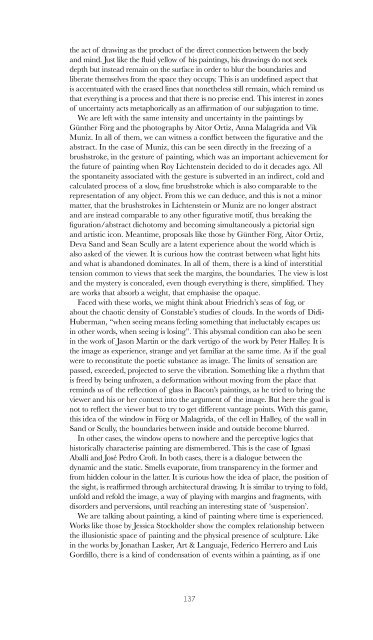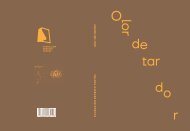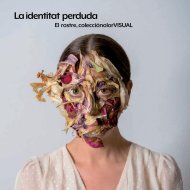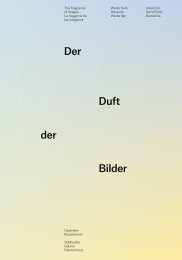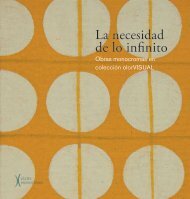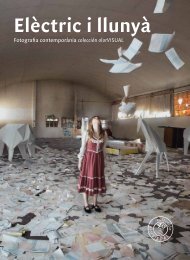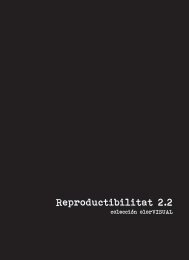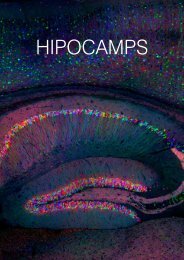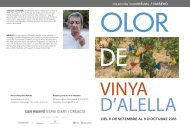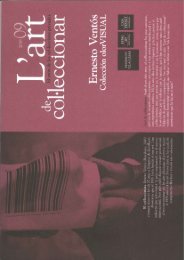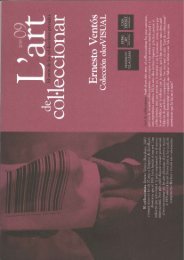Create successful ePaper yourself
Turn your PDF publications into a flip-book with our unique Google optimized e-Paper software.
the act of drawing as the product of the direct connection between the body<br />
and mind. Just like the fluid yellow of his paintings, his drawings do not seek<br />
depth but instead remain on the surface in order to blur the boundaries and<br />
liberate themselves from the space they occupy. This is an undefined aspect that<br />
is accentuated with the erased lines that nonetheless still remain, which remind us<br />
that everything is a process and that there is no precise end. This interest in zones<br />
of uncertainty acts metaphorically as an affirmation of our subjugation to time.<br />
We are left with the same intensity and uncertainty in the paintings by<br />
Günther Förg and the photographs by Aitor Ortiz, Anna Malagrida and Vik<br />
Muniz. In all of them, we can witness a conflict between the figurative and the<br />
abstract. In the case of Muniz, this can be seen directly in the freezing of a<br />
brushstroke, in the gesture of painting, which was an important achievement for<br />
the future of painting when Roy Lichtenstein decided to do it decades ago. All<br />
the spontaneity associated with the gesture is subverted in an indirect, cold and<br />
calculated process of a slow, fine brushstroke which is also comparable to the<br />
representation of any object. From this we can deduce, and this is not a minor<br />
matter, that the brushstrokes in Lichtenstein or Muniz are no longer abstract<br />
and are instead comparable to any other figurative motif, thus breaking the<br />
figuration/abstract dichotomy and becoming simultaneously a pictorial sign<br />
and artistic icon. Meantime, proposals like those by Günther Förg, Aitor Ortiz,<br />
Deva Sand and Sean Scully are a latent experience about the world which is<br />
also asked of the viewer. It is curious how the contrast between what light hits<br />
and what is abandoned dominates. In all of them, there is a kind of interstitial<br />
tension common to views that seek the margins, the boundaries. The view is lost<br />
and the mystery is concealed, even though everything is there, simplified. They<br />
are works that absorb a weight, that emphasise the opaque.<br />
Faced with these works, we might think about Friedrich’s seas of fog, or<br />
about the chaotic density of Constable’s studies of clouds. In the words of Didi-<br />
Huberman, “when seeing means feeling something that ineluctably escapes us:<br />
in other words, when seeing is losing”. This abysmal condition can also be seen<br />
in the work of Jason Martin or the dark vertigo of the work by Peter Halley. It is<br />
the image as experience, strange and yet familiar at the same time. As if the goal<br />
were to reconstitute the poetic substance as image. The limits of sensation are<br />
passed, exceeded, projected to serve the vibration. Something like a rhythm that<br />
is freed by being unfrozen, a deformation without moving from the place that<br />
reminds us of the reflection of glass in Bacon’s paintings, as he tried to bring the<br />
viewer and his or her context into the argument of the image. But here the goal is<br />
not to reflect the viewer but to try to get different vantage points. With this game,<br />
this idea of the window in Förg or Malagrida, of the cell in Halley, of the wall in<br />
Sand or Scully, the boundaries between inside and outside become blurred.<br />
In other cases, the window opens to nowhere and the perceptive logics that<br />
historically characterise painting are dismembered. This is the case of Ignasi<br />
Aballí and José Pedro Croft. In both cases, there is a dialogue between the<br />
dynamic and the static. Smells evaporate, from transparency in the former and<br />
from hidden colour in the latter. It is curious how the idea of place, the position of<br />
the sight, is reaffirmed through architectural drawing. It is similar to trying to fold,<br />
unfold and refold the image, a way of playing with margins and fragments, with<br />
disorders and perversions, until reaching an interesting state of ‘suspension’.<br />
We are talking about painting, a kind of painting where time is experienced.<br />
Works like those by Jessica Stockholder show the complex relationship between<br />
the illusionistic space of painting and the physical presence of sculpture. Like<br />
in the works by Jonathan Lasker, Art & Languaje, Federico Herrero and Luis<br />
Gordillo, there is a kind of condensation of events within a painting, as if one<br />
137


